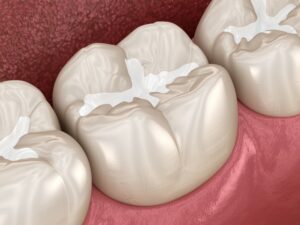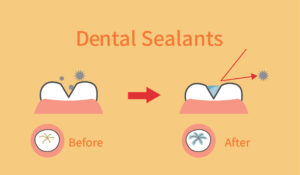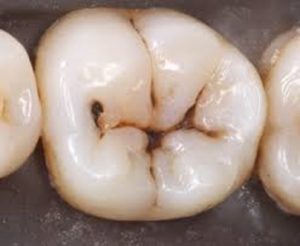Sealants: They’re Not Just for Kids!
 Many people hear the term “sealant” and assume that we are talking about dentistry for kids. Sealants are a fabulous way to prevent cavities in little teeth. But let’s don’t put them in that little box. Sealants help stop cavities from developing on any teeth to which we apply them. This week’s blog tells you all you need to know about dental sealants.
Many people hear the term “sealant” and assume that we are talking about dentistry for kids. Sealants are a fabulous way to prevent cavities in little teeth. But let’s don’t put them in that little box. Sealants help stop cavities from developing on any teeth to which we apply them. This week’s blog tells you all you need to know about dental sealants.
What is a Dental Sealant?
A dental sealant is a preventive treatment aimed at stopping the cavity process before it starts. Sealants work specifically on the biting surfaces of the teeth where lots of plaque-catching pits and grooves live. The material in dental sealants is closely related to tooth filling materials. The important difference is the runny consistency that allows it to flow freely into the deep crevices on teeth and completely fill them.
Sealant material hardens when exposed to that blue light that beeps (a dental curing light). This light, with which you might be familiar from a filling or other dental treatment, stimulates the reaction that causes the material to convert from a runny liquid into a hard shell.
 The sealant serves two important functions.
The sealant serves two important functions.
- By filling in and sealing the deep grooves, it prevents the accumulation of cavity-causing bacteria on the chewing surface of teeth.
- Because it fills in those grooves, it creates a shallow, smooth chewing surface that is much simpler to clean.
The material that a dental sealant contains has an adhesive bond with tooth enamel, making it very successful long-term.
What Does the Sealant Process Involve?
The great news about dental sealants is that they are probably one of the simplest dental procedures you can undergo. In fact, we regularly perform sealants on children as young as three years old. If they can do it, so can you! We tell the kids that the only bad thing about sealants is a yucky taste for just a second. And usually, we are able to prevent you from tasting anything at all.
 The procedure for the application of dental sealants:
The procedure for the application of dental sealants:
- Is painless.
- Does not require local anesthetic.
- Does not require drilling on the teeth.
- Takes less than a minute per tooth.
In order to place a sealant on a tooth, your dentist or dental hygienist first cleans off the tooth from any plaque and debris. Then she isolates the tooth to keep saliva from contaminating the sealant. (Salivary contamination interferes with the materials bond to the tooth and can make it fall off shortly after application.) Usually this isolation just involves some small cotton rolls around the tooth.
We then clean the tooth with an acid-etching solution that prepares the enamel for the micro-mechanical attachment of the sealant material. We rinse away the etching solution and dry the tooth well by blowing puffs of air on it. Then, we paint the sealant material onto the biting surface, allowing it to flow down into each and every pit and fissure. Once satisfied with the placement of the material, we shine the blue curing light on it to initiate the hardening process.
We will quickly evaluate the sealant to confirm attachment and a glossy smooth surface before removing everything and rinsing the mouth well.
Why Should I Consider Sealants for My Teeth?
Sealants are a valuable tool in preventing cavities on the biting surfaces of your teeth. The deep pits and grooves often collect plaque, which contains cavity-causing bacteria. In some cases, these pits and grooves are too deep or too narrow for your toothbrush bristles to clean completely.
By placing a quick, painless, and inexpensive dental sealant on a tooth, you prevent the need for a filling in the future. Fillings require local anesthetic (an injection), drilling to remove the decayed tooth structure, and restoring the defect back to normal shape and function. We know that everyone wants to spend less time in the dental chair.
The cost of a sealant is about the same as the amount you pay out of pocket when your dental insurance “covers” a filling. Typically, insurance plans do not cover sealants for adults (though they often pay 100% of sealants for children). For this reason, many people mistakenly assume that they do not need them. Even with no insurance “help” on sealants, they are a smart investment in your oral health.
Who Should Get Dental Sealants on Their Teeth?
Dental sealants are beneficial to everyone. A few categories of people are at a disadvantage when it comes to cavity risk, and these people would benefit greatly! The level of benefit depends on a person’s ability to remove plaque from the deep pits and grooves of teeth. Sometimes this relates to manual dexterity, and other times it relates to the specific anatomy of a tooth.
Patients with sub-optimal cleaning ability include:
- Young children
- Elderly people
- People with arthritis or injuries affecting the use of the hands
- Patients with physical disabilities
- Mentally-challenged patients
 When it comes to the anatomy of the teeth, you may be able to see it for yourself, or you may need your dentist’s evaluation first. A great source of information for your dentist as to whether you would benefit from dental sealants is the appearance of the biting surface of teeth. When the pits and grooves show dark brown or black stains, it is a good tooth for a sealant. Think of it this way: if a groove is deep enough to collect stain, you can be certain it is also collecting bacteria.
When it comes to the anatomy of the teeth, you may be able to see it for yourself, or you may need your dentist’s evaluation first. A great source of information for your dentist as to whether you would benefit from dental sealants is the appearance of the biting surface of teeth. When the pits and grooves show dark brown or black stains, it is a good tooth for a sealant. Think of it this way: if a groove is deep enough to collect stain, you can be certain it is also collecting bacteria.
More Questions about Dental Sealants?
Call Designer Smiles today to set up a consultation with Dr. Ann or one of our wonderful dental hygienists. They can assess your teeth for high-risk areas and recommend sealants where needed.
